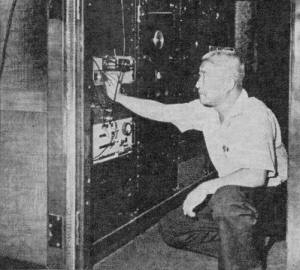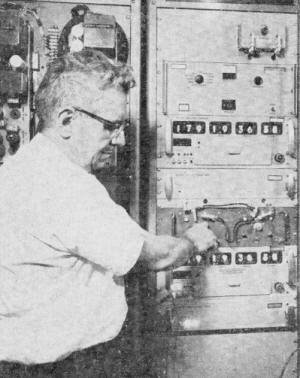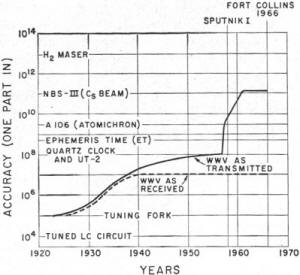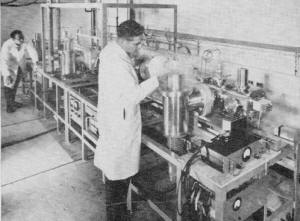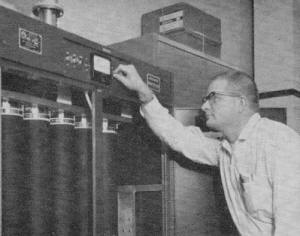WWV Moves to Colorado - Part II |
|
This is the second of a two-part series on the move of the WWV transmitter stations operated by the National Bureau of Standards (now called National Institute of Standards and Technology) from Greenbelt, Maryland, to Boulder, Colorado. WWV Part I appeared in the January 1967 edition of the ARRL's QST magazine. WWV began transmitting time / frequency standards in 1920 in order to provide a means for remote stations and laboratories to calibrate local standards that would prevent transmitting stations from interfering with each other. Although most people don't realize it, the 60 kHz signal that their "atomic" clocks and watches use to self-adjust time emanates from the WWVB antenna in Boulder. The first installment of the article discusses the history and rationale for relocating the WWV facility to a new location. This second part gets into the technical aspects of the WWV facility's equipment and operation. As usual, I am amazed at the pioneers who conceived of, designed, and implemented these kinds of operations. Here are Part I and Part II, and this is a short story on WWVB I wrote. WWV Moves to Colorado - Part II
The earliest function of WWV was to transmit standard carrier frequencies to provide frequency calibrations so that radio stations could stay on their assigned frequencies and avoid mutual interference, and to allow persons having receiving sets and wavemeters or frequency meters to calibrate them. Indeed, it is this feature of the broadcasts which is of chief interest to amateurs today. However, in the course of history the usefulness has been greatly increased by superimposing time markers and other information by a suitable program of modulation. In addition, mainly because of the needs of stations used for tracking of rockets and space vehicles, the present accuracy is far in excess of that required for the original purpose. However, for the moment, we shall confine our remarks to this original function. Quite clearly, if the objective of avoiding interference between stations on adjacent channels is to be accomplished, all frequency measurements must be coordinated: that is, they must be referred to a single standard. Similar reasoning holds for countless other physical quantities: length, force, speed, voltage, current, resistance, power, to name a few. However, most of these are not independent. They may be related by definition. For example, if one measures the time necessary for an object to travel some previously-measured distance, he can determine the speed. Or they may be related by physical laws. For example, if a known current flows through a wire of known resistance, the voltage drop between its ends, as measured by a voltmeter, must agree with that computed by Ohm's Law. Sadami Katahara, KH6DK, engineer-in-charge, makes adjustment to frequency control equipment at WWVH. Richard F. Carle K0LYM, engineer-in-charge of WWVB-WWVL, with some of the frequency control equipment of that station. Fig. 1 - Accuracy of WWV broadcasts as a function of time. Solid curve gives accuracy of the transmitted signal. Dashed curve gives accuracy of received signal at about 1,000 miles from transmitter. Degradation of accuracy is due to propagation effects. See text for information on present accuracy. Thus, to digress for a moment, we are led to the concept that all the physical measurements within the U.S.A. form the National Measurement System. This System is involved in essentially all activities of commercial and private life. It makes it possible to assure a housewife that when she pays for a pound of meat in a Denver supermarket she will receive the same amount of meat as when she shopped at her former market in Chicago. It makes it possible for the piston of an automobile motor made in Detroit to give proper performance when used in a cylinder block made in New Jersey. This System is something far greater than the National Bureau of Standards, but the Congress has given the Bureau the responsibility of providing "the basis for accurate and consistent measurements": that is, for providing standards and for leading the coordination of measurements within the System. However, the coordination is not solely confined to measurements within the U.S.A. Frequency measurements must be consistent with those outside if international QRM is to be avoided, and manufactured goods on the international market must have specifications given in units which are internationally significant. Therefore, NBS is further given the responsibility of making international comparisons. As part of its coordinating role, NBS must participate in the standardizing of the units and definitions of quantities. As the result of the recommendations of international committees to which NBS is a party, NBS has adopted for its own use the hertz as the unit of frequency, and it is encouraging others to do the same. For this reason, this unit is used in this article. In the hierarchy of measurements, "frequency" and the very closely-associated quantity "time" collectively play a very important and unique role. It has been stated above that the measurements of many quantities are interrelated. In fact, the interrelations are so numerous that it can be shown that the system of measurements of physical quantities is based upon the units of just four quantities; frequency-time is one of these, the others being length, mass, and temperature. Also, it is the only unit for which the user can obtain instantaneously a virtually direct calibration against the NBS Standard in his laboratory, factory, or home. For this latter reason, there is an effort to convert measurements of other quantities into measurements of frequency by the use of suitable transducers. Fundamental Considerations of Time and Frequency If the reader is to appreciate fully the significance of the WWV broadcasts, it is necessary to review some fundamental concepts. The measurements of both time interval and frequency are based upon some physical phenomenon which ideally is perfectly repetitive - or which, if not exactly repetitive, is accurately predictable, such as the oscillations of a piano string, the motion of a pendulum, or the electrical oscillations of a resonant circuit composed of an inductor and capacitor. Until recently, the most accurately-predictable repetitive phenomenon available was the revolution of the moon around the earth (although the results are generally expressed in terms of the time-equivalent motions of the earth about the sun). Until recently all measurements of time and frequency have been referred to this. However, it is now generally believed that the electromagnetic radiation emitted by atoms and molecules is much more uniform, and that there is no physical reason to suppose that there should be any variation provided the atoms are either isolated or maintained under constant environmental conditions. Therefore, the best present standards of time and frequency are based upon these atomic radiations. Measurements of the motions of the earth and moon referred to them reveal nonuniformities in these motions which are quite trivial from the human point of view but which, scientifically speaking, are very significant. A standard frequency is determined by the number of cycles of the reference phenomenon per second of time. Conversely, if one counts the number of cycles of standard frequency which occur between two events, he can ascertain the time interval between those events. Thus, a clock consists of (a) a physical configuration which gives rise to a repetitive phenomenon and (b) a device which counts oscillations. When one is counting the intervals between large numbers of events, it is convenient to refer measurements to one particular event, which is said to define the "epoch" of a time scale. For example, when we speak of the year 1966 A.D., we are speaking of a time scale for which the epoch is defined by the birth of Christ, and we are referring to some event occurring 1966 years later, approximately. The unit of time used by scientists is the second, and at present this has two different definitions. One of these, called the "Ephemeris" second, is based upon astronomical measurements, and we shall not give the details here. The other, the "atomic" second, is the time interval required for exactly, 9,192,631,770 cycles of the radiation absorbed or emitted by a certain transition of isolated cesium atoms. This last statement is equivalent to saying that, by definition, the frequency of this radiation is exactly 9,192,631,770 hertz. These two definitions of the second are consistent; that is, if one were to refer any given time-interval measurement either to appropriate astronomical observations or to the cesium atom, he would obtain essentially the same result for the first several digits, but he would find the measurements relative to the cesium atom to be more precise: that is, more of the digits in his answer would be meaningful. Furthermore, if one has the proper apparatus, measurements relative to the cesium atom can be carried out much more conveniently than the astronomical ones. Mainly for the first of these two reasons, atomic measurements are preferred for accurate scientific work.
Frequency and time are the primary business of WWV, and the physical facilities
described in Part I of this article exist solely for the dissemination of highly
accurate information about these two quantities. The article concludes with a description
of the basic standards used for this purpose, how they are used to control the transmitters,
a brief history of WWV and a description of the NBS organizational setup that is
responsible.
At the present, two types of time scales have been established for people who have
need for accurate time measurements. One of these is Atomic Time, which does progress
uniformly, in principle. The other is Universal Time, which progresses in synchronism
with the slightly-irregular rotation of the earth; this is required for earth navigation.
To generate Universal Time from Atomic Time, it is necessary to compensate for the
irregularities of rotation. The most widely-used type of compensation involves a
combination of (a) offsetting the frequency of the oscillator in the clock by an
amount determined by the International Time Bureau in Paris and (b) by making occasional
step adjustments of 0.1 second, as determined by the International Time Bureau in
consultation with astronomical observatories all over the world. At present, the
frequency offset is three parts in a hundred million lower than specified by the
definition of the second, an amount much too small to be noticeable by radio amateurs
and many others, but large enough to be important to those who track satellites.
This offset is held constant within any calendar year, but frequently it has been
necessary to change it from year to year. Therefore, many people feel it would be
better to eliminate offsets completely and use only step adjustments, even though
there would be a few more of them. This subject received considerable attention
at the 1966 meeting of the CCIR (International Consultative Committee on Radio)
in Oslo, and as a result of agreements made there, the use of offsets, which has
been mandatory in standard-frequency transmissions on certain frequencies, is now
optional. It is likely that in the near future many standard frequency transmissions
will eliminate them.At the present time, however, the frequencies of WWV, WWVH, and WWVL are offset, and their time signals are on the so-called NBS-UA Time Scale, which is generated by an atomic standard but which is compensated by the offset and by step adjustments to agree with Universal Time within about 0.1 sec. On the other hand, 60 kHz is not one of the frequencies covered by this international agreement, and at the present time the frequency of WWVB is not offset; the time is broadcast in accordance with the so-called Stepped Atomic Time Scale (SAT), which uses 0.2 sec. step adjustments only to keep within approximately 0.1 sec. of Universal Time. The offset and step adjustments of the NBS-UA Scale are determined by the International Time Bureau on the basis of data supplied from many sources. Step adjustments of the SAT Scale are determined by NBS on the basis of data supplied by the U.S. Naval Observatory. When a step adjustment is made on either scale, it is made at the beginning of a month and announced in advance in the Federal Register and in publications of the IEEE. While WWV, WWVH, and WWVL broadcast time on one scale and WWVB on another, Universal Time on either scale can be obtained from any broadcast by means of corrections partly coded in the broadcasts. The details of how this can be done, and much other information concerning the broadcasts, can be obtained from a booklet.1 History and Accuracy of NBS Broadcasts The first broadcasting conducted by NBS, in 1920, was on an experimental basis in order to gain technical competence. For a brief time entertainment and market reports were transmitted for the Department of Agriculture. Although speech and music were transmitted, code was used for the reports. After a short time, this work was discontinued. It should be noted, however, that these broadcasts preceded the much more publicized pioneering broadcasts of KDKA.2 Regular standard frequency broadcasts from WWV started on March 6, 1923, with the station originally located upon the grounds of NBS in Washington. (Some previous experimental tests had shown that wavemeters owned by some of the listeners were off by as much as seven percent!) Originally transmissions took place only a few hours a day, and spot frequencies were transmitted in accordance with a previously announced schedule. These frequencies ranged from below the a.m. broadcast band to considerably above. After a brief interlude in College Park, Maryland, the station was moved in 1932 to a site near the now-discontinued station in Greenbelt, Maryland. In 1931 essentially continuous operation on 5 MHz was initiated and, while oscillators using quartz crystals had been used for reference for some time previously, at that time the frequency of the station became directly crystal controlled. Operation on various spot frequencies continued as before for a time, but it tapered off while continuous operation on 2.5 MHz and on integral multiples of 5 MHz were gradually added to the service. On November 6, 1940, the station was demolished by fire. By ingenuity and hard work, a new station was improvised and put on the air within a few days. On August 1, 1943, the station went on the air with improved "permanent" facilities in Greenbelt. In 1948, similar broadcasts were initiated from WWVH in Maui, Hawaii on some of the same frequencies (at present 2.5, 5, 10, and 15 MHz.) The accuracy of the carrier frequencies of these broadcasts, as to be expected, increased with time by many orders of magnitude, as indicated by the solid curve of Fig. 1, which gives the accuracy of the ground-wave signal. This improvement was due to the innovation of improved reference standards and control methods, as noted on the figure. At present, the accuracy is of the order of a few parts in a million million (1012), and the control system is so good that this closely approaches the accuracy of the NBS Atomic Standard. It is, of course, far in excess of that needed by radio amateurs and other services for keeping their transmitters on assigned frequencies. If an amateur can measure a 50-MHz signal with an accuracy to 50Hz, he would probably consider that his accuracy is far greater than he needs. Yet this would be only one part in a million (106). Needs for other transmitting services are hardly any greater; only the tracking of satellites and pure science require this extreme accuracy. It is to be noted that a spectacular increase in accuracy resulted from the introduction of the use of a cesium atomic standard. The cesium atoms give a resonance which corresponds to a Q of about 100 to 1000 million, which exceeds that obtainable from quartz crystals and is far in excess of that obtainable from inductors and capacitors. Also, the cesium standard is far less vulnerable to environmental effects such as changes in temperature. At present, NBS and many other laboratories are continually improving atomic standards and investigating other types, such as the hydrogen maser, which many people feel is superior to the cesium standard. It is amusing to note that the quartz-controlled oscillator has passed from something which was avante garde for a primary standard to something which is a consumer item, as contained in walkie-talkies that can be purchased at many corner drugstores. The NBS cesium beam atomic frequency standard NBS-with C. J. Snider (left) and D.J. Glaze, W0YVZ Howard E. Michel, Jr., K0BPY, checks the standing wave ratio of the 15 MHz transmitter before turning on the power of the 10 kw. transmitter connected to the dummy load equipment shown here. Unfortunately, the accuracy of the signal from WWV as received at some distant point, typically 1,000 miles away, is considerably poorer than that of the transmitted signal. This is indicated by the dashed curve in Fig. 1. This deterioration of accuracy is due to Doppler shifts resulting from motion of the ionosphere. The horizontal slope of the latter portion of this curve indicates that the accuracy of the received signals is ultimately limited by this effect. For distant users the present frequency control of the station is far better than it need be. On the other hand, there are special users who require these high accuracies, and many of them are located at large distances. To satisfy their needs, other methods had to be sought. One method is to use radio stations with much lower frequencies, where propagation errors are far less serious. This approach led to the establishment of WWVB and WWVL. Another approach is physically to carry high-quality quartz clocks and small atomic clocks from NBS and other reference laboratories to field sites. NBS and other organizations are presently engaged in such an activity on a limited scale. The establishment of WWVB and WWVL was indirectly assisted by the move of the principal radio work and some of the low temperature work of NBS from Washington to new laboratories at Boulder, Colorado, the home of the University of Colorado, during 1951-1954. At about that time the standards work and propagation work were separated organizationally into the Radio Standards Laboratory (RSL) and the Central Radio Propagation Laboratory (CRPL).3 A principal purpose of the move was to provide access to better sites for propagation studies, and in due time experimental standard-frequency transmissions with low power were commenced on 60 kHz from the Boulder site and on 20 kHz with an antenna strung across Sunset Canyon, a few miles to the west. It was shown that propagation errors at distances up to 2,000 miles were negligible at 60 kHz. The 20-kHz transmission gives poorer accuracy at these distances, but at distances above 2,000 miles its errors are less than those of 60 kHz. However, should the accuracy of the frequency standards improve by another factor of 10 greater than they are today, it is almost certain that propagation errors at these two frequencies will tend to limit the accuracy of the received signals, and the carrying of clocks will play an even more important role. As the result of the success of this experimental work, the present stations WWVB and WWVL were constructed on a site approximately seven miles north of Fort Collins, Colorado, which is known as the home of Colorado State University. NASA provided the funds and sponsored the WWVL facility, and is the main potential user of its signals for synchronizing distant satellite stations. This site provided a large area of flat land of very high conductivity, which aided in improving the antenna efficiencies at these lower frequencies. Also, it was far enough away from Boulder (56 miles) to avoid serious interference to propagation studies from the high-powered transmitters. The question arises: Why was it necessary to rebuild WWV if these lower frequency transmissions give greater accuracy? The answer is that it is a matter of convenience. This article is concerned with WWV, and it would be inappropriate to give a long discussion of the details of the construction of WWVB and WWVL and the methods of using their signals. It suffices to say that most commonly-available receivers cannot receive them at all, and if their signals are to be fully utilized, special and rather expensive receivers are required. The users who need the full accuracy, such as NASA, are very important but are few in number, and are of a type that usually can afford these special receivers. On the other hand, WWV and WWVH can be received on sets which are generally available either without modification or by the addition of a very simple converter. The number of users whose needs can be met with the accuracy of WWV, using simple receivers, is very large. Amateurs, of course, are in this group. Therefore, it is considered justified to maintain and improve the service offered to this larger group. Modulation of WWV Originally the WWV transmissions provided only standard radio frequencies, with the principal purpose of making it possible for radio stations to stay on their legally assigned frequencies. In 1935, the service was augmented by modulation of the carrier to provide time pulses at one second intervals and standard musical pitch. Later, other information - such as time, time-scale corrections, and propagation warnings - was added to the modulation program, as described in detail in Reference 1. Incidentally, signals from WWV and WWVH may be partially distinguished, even though they are on the same carrier frequencies, because the station announcements are staggered and they have different silent periods (15 to 19 minutes after the hour for WWVH and 45 to 49 minutes after the hour for WWV). Propagation forecasts (mainly relevant to North Atlantic paths) are given only by WWV, and are given after each station announcement at five-minute intervals. They consist of a letter ("N" for normal, "U" for unsettled, and "W" for disturbed) and a number from one to nine to indicate the quality. Audio tones of 440 and 600 Hz are transmitted on the schedule contained in Reference 1, where one can also find explanations of other features which are of less interest to most amateurs. NBS Standards of Time and Frequency The administration of WWV is related to the manner in which the frequency of the station is controlled. Administratively, the station comes under the jurisdiction of the Radio Standards Physics Division, which, with a full-time staff of slightly more than 100 people, is one of the two technical divisions of the Radio Standards Laboratory. About one-half of the Division's staff, distributed among three sections, is devoted to time and frequency matters (the other three sections deal with radio materials, quantum electronics, and plasma). The Atomic Time and Frequency Section, headed by Dr. James A. Barnes, has the responsibility of operating the NBS Atomic Frequency Standards. The standard in use is a particular cesium atomic beam built by NBS and referred to as "NBS III." However, the cesium beam standard is a passive device, and the present one is not designed to give automatic calibrations twenty-four hours a day. Therefore, the Section also operates continuously five very stable oscillators, some controlled by quartz crystals and the others stabilized by atomic resonances. The frequencies of these oscillators are continuously compared with each other, and the data are recorded automatically. Also, once each working day they are compared to NBS III. The output of one of the five oscillators is fed to a correction device consisting of a driven phase shifter. The rate of drive of the phase shifter is adjusted to (a) make output frequency correspond to the average of the five oscillators (or, automatically, to the average of four of them if the fifth one is in serious disagreement) and (b) to correct for the average drift through aging of the oscillators. The output of this correcting device is referred to as the Drift Controlled Oscillator (DCO), and this serves as the basis for the NBS time scales and for the control of the radio stations. Connected to the DCO is also a device for producing the frequency offset required by the NBS-UA Time Scale. Connected to these oscillators and other circuits are a number of devices which count cycles and thus become clocks for telling time on both the NBS-UA and NBS-A Time Scales. Originally the epoch of the NBS-A Scale, which, unlike the Stepped Atomic Time Scale (SAT) broadcast by WWVB, has never had any step adjustments, coincided with that of UT on approximately January 1, 1958. At the present time, NBS-UA, which has been adjusted to keep within close synchronization with the rotation of the earth, lags NBS-A by about five seconds due to the irregular motion of the earth, which during the immediate past has been slowing down. Besides routine operation and maintenance of these devices, the Atomic Time and Frequency Section also does fundamental research and development of atomic frequency standards, and it possesses several others of various types, partly for backup for NBS III and partly for research purposes. An important part of this research is the study of very-low-frequency noise. Additional important work on atomic frequency standards is also carried out in the Quantum Electronics Section, headed by Dr. Donald A. Jennings. Control of the Radio Stations The NBS radio stations administratively are part of the Frequency and Time Broadcast Services Section, of which Mr. David H. Andrews is Chief. The headquarters of the Section is in Boulder. The stations are controlled by a system which makes direct reference to the NBS standards in Boulder, and at the same time provides each station with high-quality oscillators so that it can preserve a high approximation of synchronization with the NBS III in case the control link fails for a time. Furthermore, each station (counting WWVB-WWVL as one station for this purpose) is equipped with three oscillators. On the assumption that it is unlikely that more than one oscillator will fail or be in serious error at one time, it is assumed that should one disagree with the other two, those two can be considered as being correct. The new Fort Collins WWV has three new commercially-manufactured cesium-controlled oscillators. The new WWV is located in a new building about one-quarter mile away from the building housing the WWVB-WWVL transmitters, but the two stations are integrally interconnected so that one person can monitor all of the transmitters on the site and observe and correct any equipment that malfunctions. Furthermore, although the WWV and WWVB-WWVL frequency-control systems are nominally independent, in the event of failure of one of them, switches can be thrown to allow the remaining operating system to control all transmitters. Also contained in the Fort Collins complex are spare devices for generating frequency offsets. The synchronization with the NBS standards in Boulder is accomplished by the use of some monitoring receivers located in Boulder and operated continuously. The received signals are compared to a signal supplied from the DCO in the Atomic Time and Frequency Standards Section, as mentioned above. Electronic circuits determine the sign and magnitude of any frequency error, and these control the modulation of a 49.85-MHz transmitter which transmits the corrections to receivers at Fort Collins. Demodulating circuits connected to these receivers generate correction voltages which are applied to the oscillators that control the transmitters. Thus, the system forms a closed-loop electronic servo, which not only corrects for drifts in the oscillator, but also for changes in phase resulting from swaying of the antennas in the wind. Incidentally, local v.h.f. amateurs regularly use the signal from the 49.85-MHz transmitter to check their 50-MHz receivers. However, in the near future the 49.85-MHz link may be replaced by a microwave system. Control of WWVH is accomplished primarily by monitoring the WWVB and WWVL signals and correcting the oscillators. A check upon the time synchronization is made occasionally by carrying portable clocks, partly by NBS personnel and partly by others. It is the aim of Mr. Andrews to have at least four clock-carrying trips made to WWVH each year. The Frequency and Time Dissemination Section, headed by Mr. A.H. Morgan, does research on new ways of transmitting frequency and, especially, time calibrations - for example, by the use of satellites and the use of VHF meteor-scatter propagation. It studies propagation errors for correction of the WWVB and WWVL signals. It operates a number of receivers for monitoring both NBS and some non-NBS standard frequency broadcasts. Comparisons are continually made between the NBS standards and those elsewhere, both in the U.S.A. and in foreign countries. The theoretical group in the Division Office, headed by Dr. George E. Hudson, also has made important contributions to the time and frequency program through representing the Division on important committees such as the CCIR, in analyzing data, and in aiding in the determination of frequency offsets and step adjustments. Acknowledgments As stated previously, Mr. David H. Andrews is Chief of the section which administers the new station, and Mr. Peter P. Viezbicke is the engineer in charge of the design and construction of the new station. Mr. R.S. Gray served as an assistant to Mr. Viezbicke during early construction. Mr. John B. Milton is in charge of the design of the frequency-control system of the new station. The writer could not have prepared this article without the help of many individuals, especially many of those mentioned in the article, in supplying information and checking the manuscript for correctness. He is also indebted to Mr. Hugh J. Stewart for help in obtaining the photographs; to Mr. Eldred C. Wolzien for correcting the historical portions; and to Mmes. Donna Stolt and Eddyce Helfrich for typing and editing. During the last few months of operation of the Greenbelt station, it was necessary to have extra staff in order to man both the old and new stations. During this period, much of the manpower at Greenbelt was supplied under contract with the Philco Corporation by a staff headed by Mr. W.M. Swartz. 1 NBS Miscellaneous Publication 236, "NBS Standard Frequency and Time Services" (1966 Edition). For sale by Superintendent of Documents, U.S. Government Printing Office. Washington, D.C., 20402 - Price 15 cents. 2 "Measures for Progress - A History of the National Bureau of Standards, U.S. Department of Commerce, 1966. 3 In October, 1965, the organizational separation was made much more complete when CRPL, although not moved geographically, was removed from the jurisdiction of the National Bureau of Standards completely and joined to a new agency of the Department of Commerce called the Environmental Science Services Administration (ESSA). At that time CRPL was renamed the Institute for Telecommunication Sciences and Aeronomy (ITSA). It was joined by other organizations, either removed to Boulder from elsewhere or newly created, to form the Institutes of Environmental Research (IER) which is a major unit of ESSA.
Posted October 14, 2021 |
|

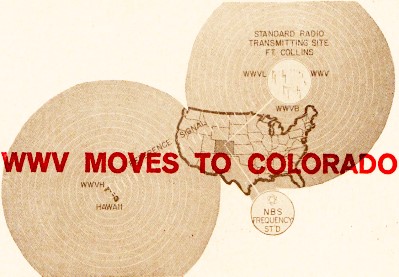 By Yardley Beers, W0EXS
By Yardley Beers, W0EXS 